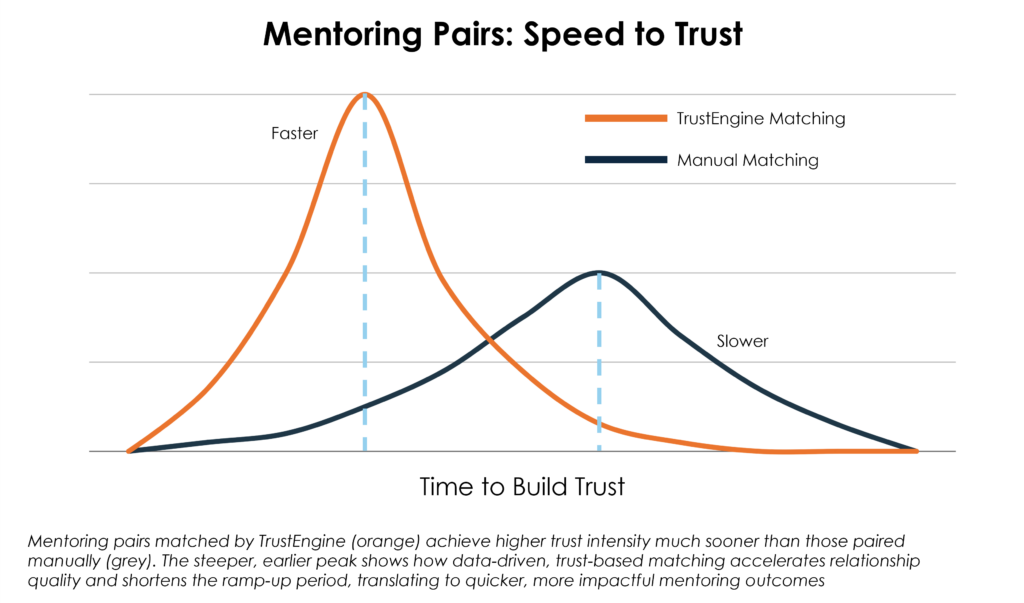Mentoring and coaching programs are powerful tools for growth and development. Research has shown that matching the right participants is crucial to ensuring these programs are successful. Traditionally, organisations have relied on manual matching, where human judgment plays a pivotal role in pairing mentors and mentees. However, as programs scale and data-driven insights become more accessible, it has become more important than ever to ensure matches are based on maximising trust development.
In this blog, we’ll explore the benefits and drawbacks of both manual matching and TrustEngine’s data-driven approach, shedding light on how you can make smarter, more impactful connections in your mentoring and coaching programs.

Ways to Match Participants: Manual vs. TrustEngine
Manual Matching
Manual matching is typically the default approach used by many organisations, especially when they’re just starting their mentoring or coaching programs, or programs are small. It involves a human administrator who reviews the profiles of participants and decides who would be best suited to work together based on things like their experience, outward personality, and goals.
TrustEngine
TrustEngine uses a sophisticated algorithm to match participants based on trust and alignment factors. The system considers a range of in-depth variables such as values, communication and decision-making styles, previous experiences, and cultural context to match participants more precisely, ensuring a higher probability of success in building trust and fostering development.
Pros and Cons of Each Approach
| Aspect | Manual Matching | TrustEngine |
| Match Accuracy | Relies on human judgment, which can lead to inconsistencies and biases. | Uses data-driven insights direct from the people in the program to ensure higher match accuracy based on trust factors. |
| Scalability | Difficult to scale as the number of participants grows, leading to inefficiencies. | Easily scalable, handling large volumes of participants while maintaining accuracy. |
| Flexibility | Offers flexibility as matches can be made based on personal insight and understanding. | Limited flexibility, as the algorithm follows predefined best practice parameters for match selection. |
| Bias and Subjectivity | Risk of human bias and emotional factors influencing decisions. | Eliminates human bias by relying on objective data and trust analysis. |
| Trust Prediction | Hard to predict how participants will build trust based on subjective match criteria. | Predicts trust dynamics using data insights and patterns, improving the likelihood of successful relationships. |
| Ease of Implementation | Simple, but can become cumbersome with larger programs. | Requires setup but offers long-term efficiency and greater returns. |
| Feedback Loops | Must be manually tracked and adjusted by administrators. | Built-in feedback mechanisms allow for ongoing optimisation. |
| Cost | High admin overhead, especially with larger programs. Additional time spent on ongoing management and adjustments. | Reduced administrative cost as matches are automated, minimising time spent on each match. |
| Time | Time-intensive, especially for larger programs. Participants may spend significant time in poorly matched relationships, delaying trust development. | Matches are optimised for trust from the start, reducing the time needed to build strong relationships and accelerating participant progress. |
How to Do Matching Right: Best Practices for Both Manual and TrustEngine
Whether you opt for manual matching or decide to leverage TrustEngine’s capabilities, there are best practices to follow to ensure the success of your mentoring or coaching programs.
Manual Matching Best Practices:
- Know Your Participants: Take time to understand the individual goals, values, and communication preferences of each side of the match.
- Set Clear Expectations: Ensure both parties know what to expect from the relationship, particularly in terms of communication and development goals.
- Monitor and Adjust: Regularly assess how the match is working. If the relationship isn’t progressing, don’t hesitate to make changes.
TrustEngine Best Practices:
- Accurate Data Input: TrustEngine’s effectiveness relies on the quality of the data provided. Data collected from participants is their own views about themselves, and is intended to inspire reflection and deeper thinking about values, preferences, and goals.
- Leverage Trust Metrics: TrustEngine provides in-depth insights into match quality. Participants can use these insights themselves to focus on the factors that will most likely build trust with their matched partner.
- Maintain Human Oversight: While TrustEngine automates the matching process, it’s important to maintain a human element for oversight and to address any nuances not captured by the algorithm.
Key Takeaway
While manual matching can work well in small-scale programs, it may fall short as programs grow, especially in terms of scalability, consistency, and trust prediction. TrustEngine offers a smarter, data-driven alternative that ensures matches are based on real-world trust factors, improving the quality of mentoring and coaching relationships. By integrating TrustEngine, organisations can reduce biases, predict trust dynamics more accurately, and scale their programs efficiently, all while freeing up time for administrators to focus on other aspects of the program.
Ultimately, the choice between manual and TrustEngine-based matching depends on your program’s scale, the complexity of your participant relationships, and how important long-term trust development is to your success.
As experienced mentors and coaches ourselves, we’d love to talk to you about the mentoring and coaching in your organisation. Get in touch to explore how TrustEngine can be your thinking partner in mentoring and coaching success.
